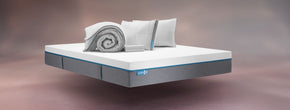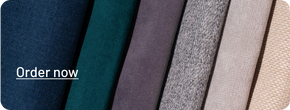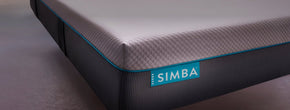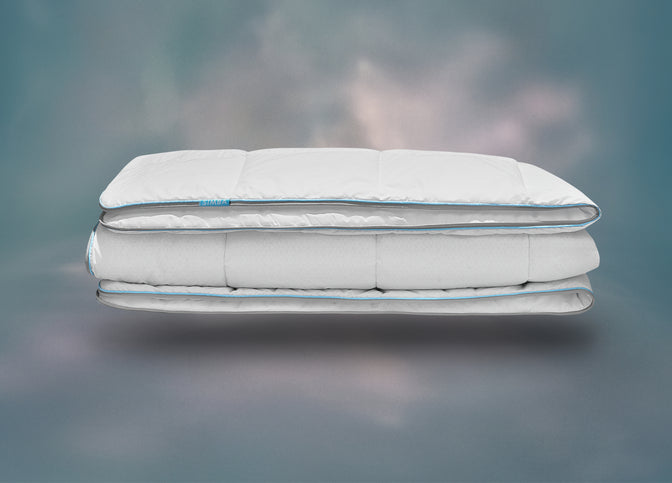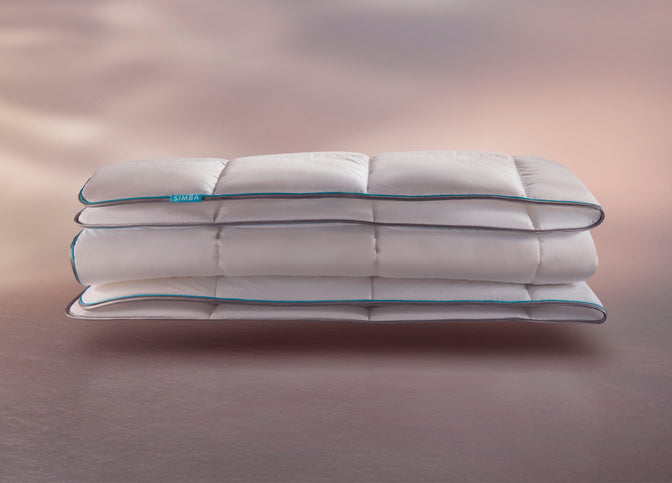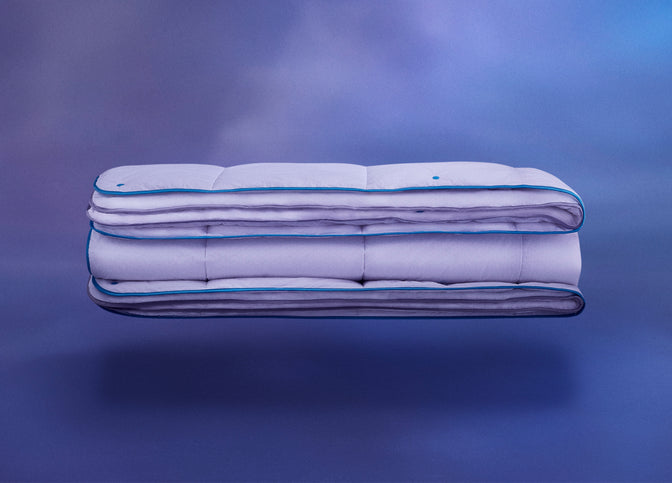How to wash a duvet - our simple guide

Keeping your duvet clean and hygienic not only improves its lifespan, but will also help you get a good night’s sleep. Washing helps cleanse the duvet of any accumulated dirt, moisture and dust. Not only does it help maintain a fresh duvet, but it refreshes the filling too. We recommend a duvet and pillow wash every few months, or a minimum of twice a year.
However, we recognise that duvets are rather cumbersome, and not the easiest thing to just throw in the wash. Whilst a single duvet will fit in your washing machine, larger sizes may not fit. We recommend taking double, king, and super king duvets to a laundrette, as their machines will have the capacity to wash them. Note that duvets aren’t suitable to dry clean, as the chemicals used in this process can affect the filling. Ideally, your duvet has properly stitched square pockets of filler. This will ensure that the filling doesn’t clump together when it’s being washed.
For smaller duvets and instances where you can’t get to the laundrette, we’ve put together a simple guide on how to wash it at home. And once you’re done, how about giving your mattress a spring clean too?
The Tools You'll Need
To clean a duvet at home - either by hand or by machine - you’ll need a couple of easy-to-access tools:
A Bath or a Tub
To hand wash a duvet, you’ll need something large - a bath will do just the trick. If you’re washing a smaller duvet, a large tub can be just as good.
Gentle Laundry Detergent
When cleaning your duvet, you don’t want to use harsh chemicals. Opt for a gentle laundry detergent that can be used at lower temperatures.
Optional: A Washing Machine
Not all duvets can fit in an at-home washing machine. However, if you have one with a big enough drum, as well as a duvet that’s suitable to clean through this process - job done! This is most suitable for duvets with synthetic fillings. Just make sure you use a gentle wash cycle. We recommend setting it to 40 degrees, with mild laundry detergent. Washing machines at a local laundrette can also be a lot larger, so this can be another option to go for.
If you have allergies, it might be tempting to turn up the temperature to get rid of irritants. However, this can have an adverse effect. Dust mites are attracted to damp and warm environments, so you might find your symptoms get worse. Our recommendation is to opt for a synthetic, highly breathable filler like Simba Renew, and make sure you air your duvet frequently.
The Process
Before you do anything - check the care label on your duvet and ensure you are following the instructions. If it mentions that it’s dry clean only, then you’ll have to forgo cleaning it yourself. If you don’t stick to the instructions, the duvet could get damaged and not perform as well as you want it to. Care instructions are included on all Simba duvets. They should be washed at 40 degrees, and tumble dried on a low temperature. You’ll also want to ensure that any bedding and covers have been removed from your duvet ahead of time too
Fill Up the Bath/Tub
You’ll want to fill up the receptacle you’re using with lukewarm water. Before it reaches the desired point, add in your detergent.
Look Out For Holes
Ahead of putting your duvet in the bath/tub, inspect it for holes. These risk tearing when cleaning, so if you find any, you can patch them up with a needle and thread. This is also the time to look for any stains that need more attention. These may need a pre-treatment.
Soak
Put in your duvet, and leave it to soak fully in the water. Ensure that it’s fully immersed in the water. Leave it for a few minutes.
Handy work
It’s time to get your hands in. Make sure they are bare and - very importantly - clean. Start making kneading movements on the duvet. This moves the water and detergent around the duvet, helping to get it clean. You can also go in harder for any areas with stubborn stains.
Drain
It’s now time to drain the water. Leave the duvet in there. Once the dirty water has drained, fill the bath/tub back up again with clean, lukewarm water. You might need to do this a few times, as you’ll be rinsing off any of the detergent left on the duvet. When you’re happy that all of the residue has gone, empty the bath/tub for the final time.
Squeeze
Once the bath/tub is empty, you’ll want to squeeze out the water absorbed by the duvet. You can do this by hand, rolling up the duvet to get rid of excess. Take note that wringing the duvet may cause wrinkles. It’s then ready to air dry. Whilst it’s drying (which can take three to four hours) check that the filling is evenly distributed. Make sure your duvet is fully dry before you put it back on your bed - including the filling. A damp duvet can be a breeding ground for mildew and mold. The Simba Renew fill in our duvets dries exceptionally quickly, do you won’t have to wait long!
How To Spot Clean A Duvet
It’s easy to get marks on a duvet, especially if you’re keen on having a cup of tea in bed in the morning. Follow the following steps to easily spot clean a duvet:
- Mop up any liquid/mess as soon as possible.
- Keep the stain in one place when doing so, being careful not to rub. You don’t want to spread it out further.
- Move and shake the filling away from the stained area, so it doesn’t mark the filling.
- Gently dab a soaked cloth over the stained spot. Make sure the water isn’t warm, as this may cause the mark to spread.
- If the stain still persists, it’s time to get out the stain remover. You can either use one specific for duvets, or make a combination of gentle detergent and water. Remember again to just keep to the stained area when using these.
- When the stain has been removed, leave your duvet to dry naturally in the warm air.
Can You Tumble Dry A Duvet?
This all comes down to the individual duvet and its care instructions. Some duvets can be tumble dried, but a lot cannot. If you do go ahead and tumble dry it, make sure you don’t choose a setting that’s too hot. If the temperature is too high, the fabric might get damaged and even scorched. For an extra tip, pop a tennis ball in with your duvet in the tumble drier. This will help maintain and restore its fluffiness.
How Much Is It To Dry Clean A Duvet?
Taking your duvet to the dry cleaners is another option to go for. This is a great option if you’re short on time, or have mobility complications that make cleaning it yourself more difficult. When it comes to dry cleaning a duvet, it’s worth shopping around for a good price. The amount it costs to dry clean a duvet can vary quite considerably from establishment to establishment, and in different parts of the country. However, as a rough estimate you should expect to pay around £30 for a double duvet.
"Makes for a great night's sleep"- Nicola C, Hybrid™ Duvet
"Light but keeps you toasty. Comfort level 10/10!"- Lucy B, Hybrid™ 3-in-1 Duvet


